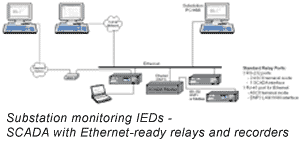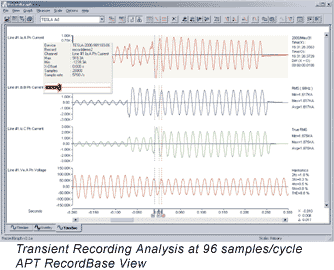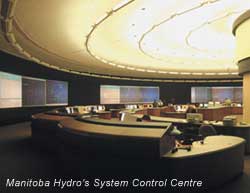Introduction
System performance is an important aspect of the power utility business and is determined by how efficiently and effectively information is used and assimilated. Often power system decisions are made in a non-real-time manner; decisions about how a power system is built, operated, protected or controlled are made prior to the operation of the system. System planners, system designers and system conditions affect the system with which load dispatchers are dealing. Largely, the success of human intervention during power system operation depends on how effectively a load dispatch operator reacts during system operating conditions. In many cases, significant system disturbances are said to have been influenced by bad weather, prior system outages or even by bad luck! The “bad luck factor” is an attempt to describe how issues stack up, often as a sequence of events.
Multi-level decisions are necessary to improve system performance; most of these decisions are influenced by the information that is available at the time of the decision. Spare capacity in a power system, for example, is determined by human decisions often made a year or more in the past. Protective relay operation during a fault condition is a factor of previously determined relay settings and algorithms. System data is collected from various sources, such as SCADA systems (e.g. DNP or Modbus), and provides dispatch operators with information to make real-time system decisions. These decisions are, however, mainly the result of system conditions that take place at a much faster pace. System faults, stability limits and equipment failures occur at any time and must be addressed quickly (e.g. protection relays must clear faults in milliseconds).
As part of system performance, system data is also used to perform post disturbance system analysis. Data collected from various IEDs (intelligent electronic devices) is used to determine what occurred in order to take necessary corrective actions and to verify system models. In addition, system performance is becoming a more critical aspect of the power utility business due to the separation of transmission and generation entities, and requirements of regulating bodies. A power utility connected to the Eastern North American grid, Manitoba Hydro (Winnipeg, Canada), has been moving aggressively in the area of system performance. One of the first North American utilities to install a wide area disturbance monitoring system, Manitoba Hydro captures dynamic swing data by cross-triggering recorder devices within its own system and next to their neighbouring utilities.
Why the Need For Greater System Performance?
As deregulation occurs in many regions, utilities directly or indirectly affected are seeing an increased need to ensure system stability and reliability. System performance is now, more than ever, a key utility function. Everyone from the CEO to the relay technician is aware that mere operation of the power system is no longer acceptable. Electric power needs to reach loads in the most cost effective manner possible, while maintaining secure operation. From generation to load, and everywhere in between, system performance monitoring, recording and analysis helps ensure that the utility delivers power 24 hours a day, 365 days a year.
Collecting the appropriate system data indicates where improvements in system performance are achievable. The resulting increases in power system efficiencies mean increased investor return. A highly efficient system also attracts customers who need a secure source of power. One example is the silicon manufacturing industry, where a single production batch may be worth hundreds of thousands of dollars (or could be worthless if a power quality issue develops during the manufacturing process). Some manufacturers today are only able to achieve their required level of service by using their own in-house generation as a primary source with the local power utility as a backup source. This constant pull between efficiency and cost reduction requires enhanced system performance.
In order to achieve better system performance several factors need to be reviewed:
A wide variety of equipment contributes to successful system performance including generators, CTs/PTs (conventional and optical), breakers, relays, switches, and SCADA systems. Since utilities can only manage what they measure, a variety of monitoring, recording and measurement devices must also be part of their equipment. Specifically, these devices include recorders, meters and other intelligent electronic devices (IEDs) that provide data to illustrate system performance, equipment performance and provide system model verification to optimize operating guidelines and criteria.
System performance is a term that reflects how well a power system is operated, apart from simple performance statistics. As such, system IEDs provide data such as breaker performance over time that can be used to drive maintenance programs. In the long run, the goal is to optimize equipment performance and minimize actual maintenance costs.
Regulatory Bodies Influencing System Performance
The benefits of system interconnection have been well established over the years. Interconnections allow power systems to share their strengths, lessening the likelihood that one issue brings down an entire power system. On the negative side, however, faults or disturbances affect the operation of other utilities, creating danger of stability issues or power quality problems.
Deregulation has pushed utilities to do more with less. To balance these forces, the North American Electric Reliability Council (NERC) have developed operating and planning standards to insure a reasonable level of system performance. Regulations cover areas such as monitoring and recording sample rate (e.g. an IED should sample at a minimum of 64 samples per cycle to produce an analog waveform that is acceptable to use for system performance analysis and reporting). Changes in NERC standards and deregulation have prompted utilities to re-think their approach to system performance monitoring. In particular, regulations covering system disturbance, transient recording speed and reporting response time require utilities to consider updating and tuning their system procedures and system equipment.
Monitoring Devices Ensure System Performance
In the past many system components that contributed to overall performance were isolated by function: protection relays, meters, sequence of events recorders, fault detectors, fault recorders, swing recorders and other devices. However, the introduction of IEDs with powerful processors to collect and process data has enabled more and more of these functions to be integrated together.
Useful data is collected in substations or other locations by electrical equipment such as integrated high-quality recording relays, meters, RTUs, and integrated multi-mode recording devices (for example, the APT TESLA recorder). Increasingly, essential substation components integrate the key functions of protection, recording, metering and communication in a single IED. This integration helps minimize installation costs, on-going maintenance and complexities due to inter-related functionality. For example, some protection relays now provide a wide range of standard protection functions and high-quality recording for transient (e.g. 96 samples per cycle), swing, trend and event recording. These relays also provide breaker monitoring and plug-and-go SCADA over Ethernet, all in a single integrated platform. From a system performance perspective, this helps reduce the data amounts by concentrating it in a few key elements. For example, there are digital fault recorders that fully support SCADA over Ethernet, calculate fault location and accept multiple AC and DC input quantities. In some respects, the ability for various components to perform auxiliary monitoring tasks and link the protection relay with recording and monitoring functions, greatly improves management of system performance.
Collected Data Enhances System Performance
Once data is retrieved it is used in a variety of different ways related to system performance. First, a utility’s control center needs the real-time data in order to manage their system’s generation, transmission, distribution and loading. If the data has been pre-processed into useful information (such as transformer overload monitoring or fault location information), system real-time performance can be handled more efficiently and effectively. Second, system performance groups require trend, system stability and transient records to review how the system performed during a period of system stress. Some of the very same data is used to create mandated regulatory reports, to build shared reports between inter-utility members and to verify system models (e.g. power system dynamic simulation, state estimator, power flow, contingency analysis).
Manitoba Hydro’s Effort To Achieve System Performance
Manitoba Hydro is interconnected with several utilities in Canada and the USA. Their hydraulic system is designed to serve Manitoba’s energy needs, even during times of poorer water conditions. Due to this design, conditions are generally favourable to provide surplus energy for export. Manitoba Hydro has a unique combination of generation, high-voltage DC and AC transmission, and distribution system components. DC transmission and its important ties to Canadian and US utilities south of the border (various MAPP members), make system performance a critical part of the Manitoba Hydro system operation.
Back in 1980, Manitoba Hydro installed one of the first wide area monitoring (WAM) systems for dynamic system triggered recording. This system allowed a single site to identify that a system disturbance was occurring and cross-trigger other sites to record a system snapshot at a specific point in time. This information is vital for following tie line load guidelines and to perform system model verification. Without this tool, trial and error would have been the only option, an approach unacceptable to many customers affected in the various areas. Manitoba Hydro’s experience in operating tie-lines to neighbouring utilities has created world-class relationships that ensure system performance. Many utilities electrically near Manitoba Hydro have also incorporated cross-triggered wide area monitoring systems that allow them to monitor their own respective systems and to share system disturbance data with their neighbours. The results have enabled an aggressive yet secure strategy regarding system performance practices.
Currently, Manitoba Hydro is upgrading their wide area monitoring system with completely time-synchronized components that provide dynamic swing, transient, trend and event recording with Ethernet access using APT TESLA Recorders and APT RecordBase Central Station from NxtPhase. In the future, this system will be integrated with others in the MAPP region to allow for cross-triggering between utilities and streamlined record exchange.
Conclusion
Changing regulations and inter-utility relationships require enhanced approaches to system performance and related monitoring. Requirements for higher sample rate recordings and timely system reports are pushing system performance to handle system information more effectively and efficiently. Today, utilities have integrated multi-function protection, monitoring, recording and metering devices that provide data using SCADA and high-speed communication (e.g. Ethernet/TPC-IP). These devices are also able to pre-analyze data and turn it into useful information about fault location and transformer overload conditions. In the end, better information improves system performance and, in turn, results in better system stability and reliability.
System performance is an important aspect of the power utility business and is determined by how efficiently and effectively information is used and assimilated. Often power system decisions are made in a non-real-time manner; decisions about how a power system is built, operated, protected or controlled are made prior to the operation of the system. System planners, system designers and system conditions affect the system with which load dispatchers are dealing. Largely, the success of human intervention during power system operation depends on how effectively a load dispatch operator reacts during system operating conditions. In many cases, significant system disturbances are said to have been influenced by bad weather, prior system outages or even by bad luck! The “bad luck factor” is an attempt to describe how issues stack up, often as a sequence of events.
Multi-level decisions are necessary to improve system performance; most of these decisions are influenced by the information that is available at the time of the decision. Spare capacity in a power system, for example, is determined by human decisions often made a year or more in the past. Protective relay operation during a fault condition is a factor of previously determined relay settings and algorithms. System data is collected from various sources, such as SCADA systems (e.g. DNP or Modbus), and provides dispatch operators with information to make real-time system decisions. These decisions are, however, mainly the result of system conditions that take place at a much faster pace. System faults, stability limits and equipment failures occur at any time and must be addressed quickly (e.g. protection relays must clear faults in milliseconds).
As part of system performance, system data is also used to perform post disturbance system analysis. Data collected from various IEDs (intelligent electronic devices) is used to determine what occurred in order to take necessary corrective actions and to verify system models. In addition, system performance is becoming a more critical aspect of the power utility business due to the separation of transmission and generation entities, and requirements of regulating bodies. A power utility connected to the Eastern North American grid, Manitoba Hydro (Winnipeg, Canada), has been moving aggressively in the area of system performance. One of the first North American utilities to install a wide area disturbance monitoring system, Manitoba Hydro captures dynamic swing data by cross-triggering recorder devices within its own system and next to their neighbouring utilities.
Why the Need For Greater System Performance?
As deregulation occurs in many regions, utilities directly or indirectly affected are seeing an increased need to ensure system stability and reliability. System performance is now, more than ever, a key utility function. Everyone from the CEO to the relay technician is aware that mere operation of the power system is no longer acceptable. Electric power needs to reach loads in the most cost effective manner possible, while maintaining secure operation. From generation to load, and everywhere in between, system performance monitoring, recording and analysis helps ensure that the utility delivers power 24 hours a day, 365 days a year.
Collecting the appropriate system data indicates where improvements in system performance are achievable. The resulting increases in power system efficiencies mean increased investor return. A highly efficient system also attracts customers who need a secure source of power. One example is the silicon manufacturing industry, where a single production batch may be worth hundreds of thousands of dollars (or could be worthless if a power quality issue develops during the manufacturing process). Some manufacturers today are only able to achieve their required level of service by using their own in-house generation as a primary source with the local power utility as a backup source. This constant pull between efficiency and cost reduction requires enhanced system performance.
In order to achieve better system performance several factors need to be reviewed:
- Training and management skills
- Quality and effectiveness of installed equipment
- Efficiency of operating practices
- Maintenance practices
A wide variety of equipment contributes to successful system performance including generators, CTs/PTs (conventional and optical), breakers, relays, switches, and SCADA systems. Since utilities can only manage what they measure, a variety of monitoring, recording and measurement devices must also be part of their equipment. Specifically, these devices include recorders, meters and other intelligent electronic devices (IEDs) that provide data to illustrate system performance, equipment performance and provide system model verification to optimize operating guidelines and criteria.
System performance is a term that reflects how well a power system is operated, apart from simple performance statistics. As such, system IEDs provide data such as breaker performance over time that can be used to drive maintenance programs. In the long run, the goal is to optimize equipment performance and minimize actual maintenance costs.
Regulatory Bodies Influencing System Performance
The benefits of system interconnection have been well established over the years. Interconnections allow power systems to share their strengths, lessening the likelihood that one issue brings down an entire power system. On the negative side, however, faults or disturbances affect the operation of other utilities, creating danger of stability issues or power quality problems.
Deregulation has pushed utilities to do more with less. To balance these forces, the North American Electric Reliability Council (NERC) have developed operating and planning standards to insure a reasonable level of system performance. Regulations cover areas such as monitoring and recording sample rate (e.g. an IED should sample at a minimum of 64 samples per cycle to produce an analog waveform that is acceptable to use for system performance analysis and reporting). Changes in NERC standards and deregulation have prompted utilities to re-think their approach to system performance monitoring. In particular, regulations covering system disturbance, transient recording speed and reporting response time require utilities to consider updating and tuning their system procedures and system equipment.
Monitoring Devices Ensure System Performance
In the past many system components that contributed to overall performance were isolated by function: protection relays, meters, sequence of events recorders, fault detectors, fault recorders, swing recorders and other devices. However, the introduction of IEDs with powerful processors to collect and process data has enabled more and more of these functions to be integrated together.
Useful data is collected in substations or other locations by electrical equipment such as integrated high-quality recording relays, meters, RTUs, and integrated multi-mode recording devices (for example, the APT TESLA recorder). Increasingly, essential substation components integrate the key functions of protection, recording, metering and communication in a single IED. This integration helps minimize installation costs, on-going maintenance and complexities due to inter-related functionality. For example, some protection relays now provide a wide range of standard protection functions and high-quality recording for transient (e.g. 96 samples per cycle), swing, trend and event recording. These relays also provide breaker monitoring and plug-and-go SCADA over Ethernet, all in a single integrated platform. From a system performance perspective, this helps reduce the data amounts by concentrating it in a few key elements. For example, there are digital fault recorders that fully support SCADA over Ethernet, calculate fault location and accept multiple AC and DC input quantities. In some respects, the ability for various components to perform auxiliary monitoring tasks and link the protection relay with recording and monitoring functions, greatly improves management of system performance.

Collected Data Enhances System Performance
Once data is retrieved it is used in a variety of different ways related to system performance. First, a utility’s control center needs the real-time data in order to manage their system’s generation, transmission, distribution and loading. If the data has been pre-processed into useful information (such as transformer overload monitoring or fault location information), system real-time performance can be handled more efficiently and effectively. Second, system performance groups require trend, system stability and transient records to review how the system performed during a period of system stress. Some of the very same data is used to create mandated regulatory reports, to build shared reports between inter-utility members and to verify system models (e.g. power system dynamic simulation, state estimator, power flow, contingency analysis).

And finally, by playing the recording back via a relay test set, utilities can verify a protective relay’s performance or validate a relay setting.
Manitoba Hydro’s Effort To Achieve System Performance
Manitoba Hydro is interconnected with several utilities in Canada and the USA. Their hydraulic system is designed to serve Manitoba’s energy needs, even during times of poorer water conditions. Due to this design, conditions are generally favourable to provide surplus energy for export. Manitoba Hydro has a unique combination of generation, high-voltage DC and AC transmission, and distribution system components. DC transmission and its important ties to Canadian and US utilities south of the border (various MAPP members), make system performance a critical part of the Manitoba Hydro system operation.

Back in 1980, Manitoba Hydro installed one of the first wide area monitoring (WAM) systems for dynamic system triggered recording. This system allowed a single site to identify that a system disturbance was occurring and cross-trigger other sites to record a system snapshot at a specific point in time. This information is vital for following tie line load guidelines and to perform system model verification. Without this tool, trial and error would have been the only option, an approach unacceptable to many customers affected in the various areas. Manitoba Hydro’s experience in operating tie-lines to neighbouring utilities has created world-class relationships that ensure system performance. Many utilities electrically near Manitoba Hydro have also incorporated cross-triggered wide area monitoring systems that allow them to monitor their own respective systems and to share system disturbance data with their neighbours. The results have enabled an aggressive yet secure strategy regarding system performance practices.
Currently, Manitoba Hydro is upgrading their wide area monitoring system with completely time-synchronized components that provide dynamic swing, transient, trend and event recording with Ethernet access using APT TESLA Recorders and APT RecordBase Central Station from NxtPhase. In the future, this system will be integrated with others in the MAPP region to allow for cross-triggering between utilities and streamlined record exchange.
Conclusion
Changing regulations and inter-utility relationships require enhanced approaches to system performance and related monitoring. Requirements for higher sample rate recordings and timely system reports are pushing system performance to handle system information more effectively and efficiently. Today, utilities have integrated multi-function protection, monitoring, recording and metering devices that provide data using SCADA and high-speed communication (e.g. Ethernet/TPC-IP). These devices are also able to pre-analyze data and turn it into useful information about fault location and transformer overload conditions. In the end, better information improves system performance and, in turn, results in better system stability and reliability.









